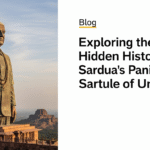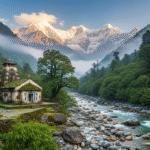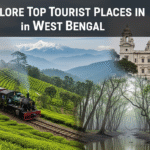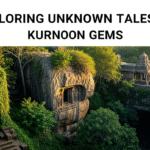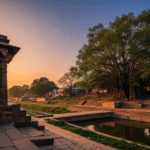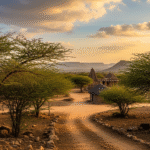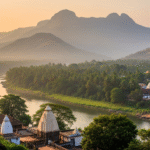Did you know Dharamshala has beautiful Himalayan views? You can find hotels as cheap as Rs 200 a night here. Even though it looks fancy, Dharamshala is split into Lower Dharamshala and Upper Dharamshala (McLeod Ganj). It’s a great, affordable place for visitors. Let’s learn fun facts about Dharamshala and see why it’s so special.
Dharamshala is in Himachal Pradesh. It’s famous but also full of history and spirit. After an earthquake in 1905, it became known for health retreats. Since 1959, the Dalai Lama has been here. This has made Dharamshala a key place for Tibetan culture.
Key Takeaways
- Dharamshala is divided into two distinct areas: Lower Dharamshala and Upper Dharamshala (McLeod Ganj).
- The city caters to all budgets, with hotel prices ranging from Rs 200 to Rs 6,500 per night.
- Spotlighted as a health resort post the 1905 earthquake, Dharamshala is renowned for its natural beauty and health benefits.
- The Tsuglagkhang Complex serves as a major tourist attraction and the venue for public and private sessions of the Dalai Lama.
- Rich in history and spirituality, the town remains a focal point for Tibetan culture in India.
Dharamshala: A Crucial Base for Tourism in India
Dharamshala lies in Himachal Pradesh’s Kangra district. It’s very important for tourism. This town mixes beauty with culture perfectly.
It’s also the winter capital of the state since 2017. This fact makes it more attractive to travelers from all around.
Accommodation Options
Planning a trip? It helps to know the best places to stay. You can find anything from luxurious hotels to cozy guesthouses. The Pavilion and Fortune Park Moksha are great if you love comfort.
In McLeod Ganj and Dharamkot, smaller places offer a warm touch. Knowing your options makes the trip nicer.
Tourist Services and Facilities
Dharamshala has everything tourists might need. There are hospitals, ATMs, and places to access the internet. You’ll find Wi-Fi spots too, to keep in touch.
Tour guides in the city can show you the blend of Tibetan and Indian life. With their help, you won’t miss a thing. The city’s care for visitors makes it a top choice anytime.
Its history is rich, from ancient dynasties to welcoming Tibetan refugees in 1959. The town is split into two parts, each with unique charms.
This place is a hub for learning about Tibetan culture against a Himalayan backdrop. The mix of culture and nature guarantees an unforgettable visit.
For more on Dharamshala’s history and characteristics, see its detailed profile.
The Chandan Nath Temple: A Historic Landmark
The Chandan Nath Temple is a major part of Dharamshala’s rich history. It is more than a thousand years old. It matters a lot to those who love history and to those on a spiritual journey. Visiting this temple lets people learn about interesting information Dharamshala has. It’s a deep dive into Dharamshala facts and history.
A Pilgrimage Destination
The Chandan Nath Temple is known for its amazing architecture. But it’s also a sacred place for many. Devotees come from all over India. They come to feel closer to the divine. The temple’s environment is calm and uplifting. It has comforted those on a spiritual path for hundreds of years.
Architectural Significance
This temple shows the beauty of ancient Indian art. The carvings and craftsmanship tell stories of the past. People love seeing how old and beautiful it is. The Chandan Nath Temple is a special place. It is for worship and remembering the area’s history.
Historical Use of Dharamshala Since the 16th Century
Dharamshala is nestled in the Himalayas. It has welcomed travelers and seekers since the 16th century. The name “Dharamshala” comes from Sanskrit. It means a resting place for pilgrims. This city has changed over time but kept its special feel.
Facts about Dharamshala show it’s nice all year. From March to June, it’s warm, between 22°C and 38°C. This weather is great for trekking and seeing places. People come from cities like Chandigarh and Delhi to enjoy it.
In winter, from October to February, it gets really cold. Dharamshala becomes a quiet place. Visitors come to find peace and maybe see snow. It’s also known as Himachal Pradesh’s winter capital since old times.
Since 1575, Dharamshala has been a hub for Tibetan Buddhism. The Namgyal Monastery was founded then. The Dalai Lama lives here now. This adds a spiritual touch to the city.
People have always come to Dharamshala for peace. There’s the St. John in the Wilderness Church from 1852. It’s got a neo-Gothic design. Located in a cedar forest, it shows the city’s history and beauty.
| Time Period | Key Developments |
|---|---|
| 16th Century | Establishment as a haven for sanyasis and pilgrims |
| Colonial Era | Recognition as the winter capital of Himachal Pradesh |
| 1852 | Construction of St. John in the Wilderness Church |
| 1959 Onwards | Resettlement of the Dalai Lama and Tibetan government-in-exile |
Learning facts about Dharamshala helps us see its rich history and spirit. Its legacy from the 16th century continues. It remains a key spot for tourists and those seeking spiritual growth.
British Influence on Dharamshala
The story of Dharamshala is closely linked with British history. This town lies high above sea level. It was a summer spot for British folks because of its nice weather.
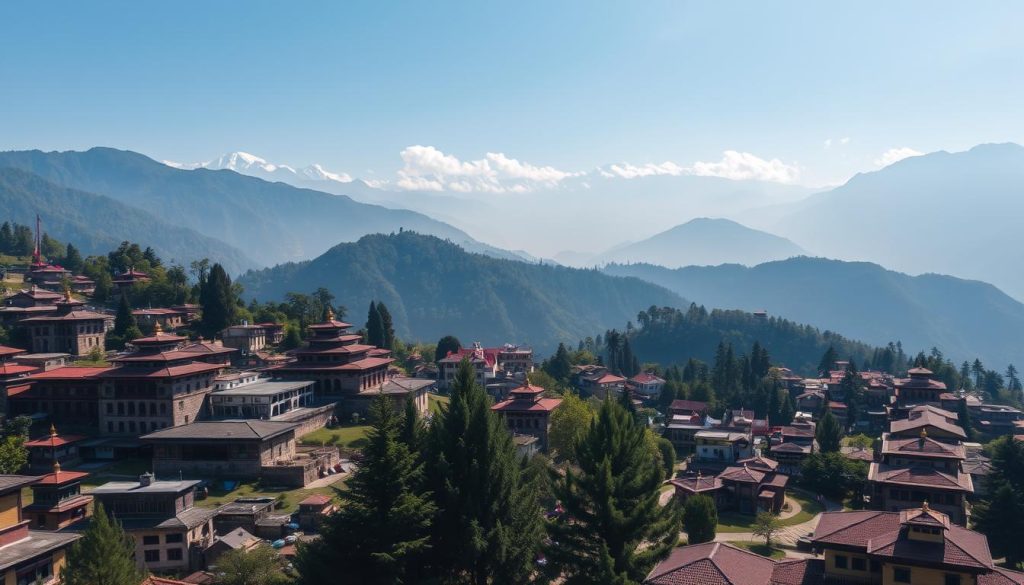
The British Civil Services
In the 19th century, the British set up a military spot in Dharamshala. The area’s cool weather was perfect for British officials during summer. This blend led to big changes in the area, affecting both life and buildings.
Architectural Heritage
Today, British style can still be seen in Dharamshala’s buildings. These structures show a mix of British and local design. They tell a story about Dharamshala’s past and add beauty to the town.
Diverse Religious Harmony in Dharamshala
Dharamshala shines as a beacon of cultural diversity, where different religions live together peacefully. This town shows how people from various backgrounds can respect and promote peace. Everyone, from locals to Tibetan refugees, works towards mutual understanding.
Temples, Mosques, and Monasteries
In Dharamshala, many religious sites highlight its vibrant culture. Hindu temples, Buddhist monasteries, mosques, and churches stand side by side. Among these, the Jwalamukhi Temple and the Dalai Lama Temple are notable. Buddhists, Muslims, Christians, and Sikhs all contribute to this religious diversity.
Interfaith Events and Festivals
Dharamshala celebrates festivals that bring people together, regardless of their religion. Losar and Holi are examples of these joyful events. They show how diverse cultures can celebrate together. Places like The Tibet Museum and Kalachakra Temple also promote understanding between faiths. Such events and places help everyone feel united and respected.
| Religion | Major Sites | Festivals |
|---|---|---|
| Buddhism | Dalai Lama Temple, Kalachakra Temple | Losar |
| Hinduism | Jwalamukhi Temple | Holi |
| Islam | Local Mosques | Eid |
| Christianity | Local Churches | Christmas |
| Sikhism | Local Gurdwaras | Vaisakhi |
Tibetan Influence and the Dalai Lama
Since 1959, when the 14th Dalai Lama, Tenzin Gyatso, arrived, Dharamshala changed. It became the center of the Tibetan diaspora. The town is deeply shaped by the Tibetan government-in-exile and the Dalai Lama himself. To discover Dharamshala fun facts about its Tibetan connections, we need to explore its impact.
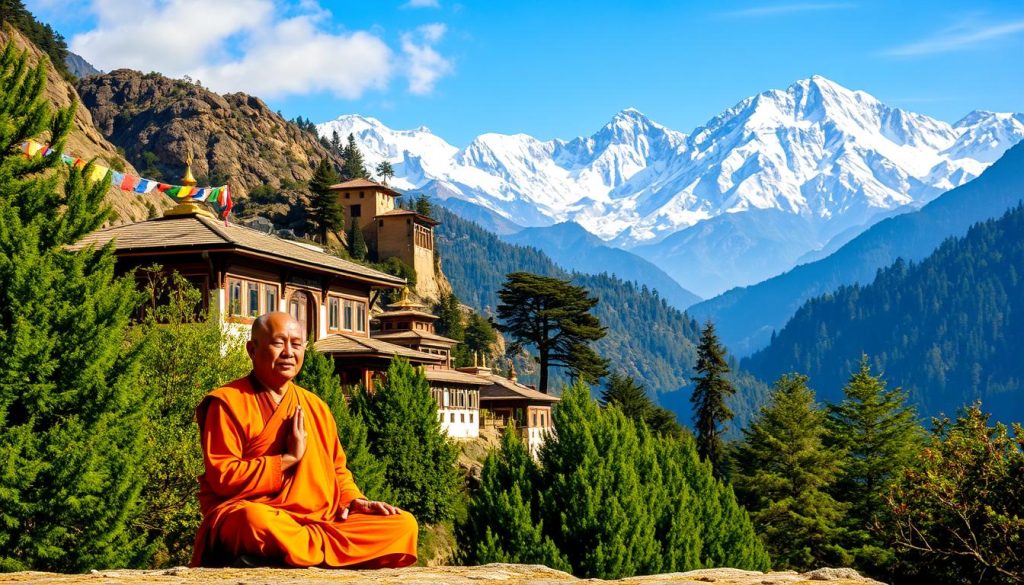
Tenzin Gyatso was born on July 6, 1935, in Qinghai, China. He fled to India in 1959 after a failed uprising. At 23, he earned the highest Buddhist philosophy degree in Lhasa. The Central Tibetan Administration started with his escape. It helped bring democratic changes inside the Tibetan community, like the 1990 election of the Eleventh Tibetan Assembly.
The Dalai Lama has visited 67 countries on 6 continents. His efforts have won him over 150 awards, including the Nobel Peace Prize. Since the 1980s, he has talked with scientists and written more than 110 books.
In 2011, a big change happened. The Dalai Lama handed over power to a democratically elected leader. This ended a 368-year tradition of dual leadership in Tibet. Guidelines for finding the next Dalai Lama were made in 2011. This was to keep the process honest and free from political misuse.
To really know Dharamshala, understand how the Dalai Lama’s influence merges with the town. It has become a place full of Tibetan culture and spiritual learning.
| Fact | Details |
|---|---|
| Birth and Early Life | Tenzin Gyatso born in 1935 in Qinghai province, China |
| Education | Completed Geshe Lharampa degree’s final exam in 1959 in Lhasa |
| Escape to India | Fled to exile in India following a failed uprising against Chinese forces |
| Central Tibetan Administration | Formed in 1959 and elected 46 members in 1990 |
| Global Influence | Travelled to over 67 countries across 6 continents |
| Nobel Prize | Awarded the Nobel Prize for Peace in 1989 |
| Authority Transfer | Transferred temporal authority to elected leader in 2011 |
| Books Authored | Authored or co-authored over 110 books |
Facts about Dharamshala: A Melting Pot of Cultures
Dharamshala is a beautiful mix of Tibetan and Indian cultures. It showcases traditions well. You can see this mix in its monasteries, local celebrations, and daily life. Tourists get to dive into these different cultures. This makes their trip more meaningful.
Tibetan and Indian Cultural Blend
Since 1959, Dharamshala has been the 14th Dalai Lama’s home-in-exile. This has brought a strong Tibetan feel to the area. Alongside it, you’ll find rich Indian traditions. The Tsuglagkhang Complex, hosting the Dalai Lama, is a must-see. It attracts many looking for peace and insight.
Dharamshala has over 100 monasteries, showing Tibetan Buddhist practices. McLeod Ganj sits high at 2,082 meters. It shows off the stunning mix of cultures. Here, visitors find both spiritual depth and beautiful views.
Local Cuisine and Handicrafts
Discovering local food is key in Dharamshala. It blends Tibetan and Himachali tastes. You must try dishes like momos, thukpa, Dham, and Siddu. They are favorites among visitors. McLeod Ganj Market and Kotwali Bazaar offer wonderful Tibetan crafts. You’ll find jewelry and clothes that tell of Dharamshala’s rich culture.
| Top attractions | Unique characteristics |
|---|---|
| Tsuglagkhang Complex | Residence of the Dalai Lama |
| McLeod Ganj Market | Handicrafts and traditional clothing |
| Local Cuisine | Momos, Thukpa, Dham, Siddu |
The Connection to Maharaja Hari Singh
Maharaja Hari Singh was very important in Northern India’s history. He did a lot to shape Dharamshala. His story is a big part of the town’s past and how it is today.
Historical Significance
Maharaja Hari Singh greatly impacted Dharamshala. He had forward-thinking ideas. He helped bring the Muslim community together after the partition.
His choice to join India on October 26, 1947, was very important. It helped Jammu and Kashmir become part of India. This also made Dharamshala the diverse place it is now.
Present-Day Impact
Even today, we can see Maharaja Hari Singh’s influence in Dharamshala. His focus on including everyone and bringing in new ideas has made a big difference. The town is now a mix of many cultures.
Education got better when he was in charge. More people learned to read and write. The number of students going to school also went up. This shows how the community improved.
| Event | Year |
|---|---|
| Maharaja Hari Singh signed the Instrument of Accession | 1947 |
| Indian troops landed in Kashmir | 1947 |
| Sheikh Abdullah appointed as administrator | 1947 |
| Yuvraj Karan Singh appointed as Regent | 1949 |
The story of Maharaja Hari Singh and Dharamshala mixes old cultures and new dreams. This makes the area very special in India.
Transportation and Connectivity in Dharamshala
Dharamshala sits in the Kangra District of Himachal Pradesh. It’s known for easy access by road, rail, and air. This makes it great for travelers from all over.
Road and Rail
You can get to Dharamshala by road from big cities like Chandigarh, Delhi, and Shimla. There’s a range of bus services to choose from. These include regular buses to more comfy ones with air conditioning.
The place is also connected through railways. You can catch a train to Pathankot, then drive about 2.5 hours to get here. Or, take a scenic train ride to the Kangra Valley. Another way is by the narrow gauge train to Jogindernagar, getting off at Chamunda Marg.
If flying is your preference, Gaggal Airport is only 15 kilometers away. A car ride from there to Dharamshala takes about 30 to 45 minutes. Being close to Gaggal Airport makes visits here super convenient.
In Dharamshala, buses run by the state are the main local transport. Because of the city’s steep roads, buses have to take longer routes around the city. This affects taxis and private cars too.
| Travel Mode | Details |
|---|---|
| By Road | Daily bus services from Chandigarh, Delhi, and Shimla |
| By Rail | Pathankot (85 km away), Narrow gauge train to Kangra, Jogindernagar line to Chamunda Marg |
| By Air | Gaggal Airport, 15 km south, 30-45 minutes by car |
Exploring the Kangra Valley
Just a little way from Dharamshala sits the beautiful Kangra Valley. It’s famous for its breathtaking views and historic places. It extends the culture of Dharamshala, giving visitors peace and rich cultural insights. There, one can explore everything from old forts and quiet lakes to ancient temples.
Kangra Fort
The Kangra Fort is among India’s oldest and biggest forts. The royal Rajput family of Kangra State built it. It provides stunning views all around. This fort, about 40 km from Pragpur village, lets visitors dive into the area’s deep cultural roots.
Dal Lake
Dal Lake in McLeod Ganj is known for its calmness and beauty. It opens daily from 7:00 am to 8:00 pm for peaceful walks and boating. The lake is a peaceful place for those wanting to see Dharamshala’s quiet side.
Baijnath Temple
The Baijnath Temple is an old place dedicated to Lord Shiva. It provides spiritual peace and a look at impressive architecture. Pilgrims and those who love architecture come here to find out interesting facts and enjoy its culture.
| Attraction | Location | Unique Feature |
|---|---|---|
| Kangra Fort | 40 km from Pragpur | Oldest and largest fort in India |
| Dal Lake | McLeod Ganj | Peaceful walks and boating |
| Baijnath Temple | Baijnath | Ancient Shiva temple |
Conclusion
Dharamshala’s journey shows us a town full of life and history. It perfectly mixes old traditions with today’s world. This place is known for its beautiful mix of culture, religion, and nature.
It is easy for visitors to feel the deep spiritual and cultural roots here. From the Tibetan Namgyal Monastery to the high Himalayas, there is much to see. Places like Triund offer stunning views everyone should see.
Getting to Dharamshala is not hard. The Gaggal Airport is just 13 kilometers away. Plus, there’s a train station in Pathankot, about 85 kilometers far. Buses from big cities like Delhi make the trip often.
This spot is perfect for those seeking adventure or a quiet time with nature. Activities like paragliding and river rafting keep you busy. The Dhauladhar Wildlife Sanctuary is a must-visit for animal lovers.
The food in Dharamshala is a treat for your taste buds. You can try local dishes and Tibetan food like momos. The Tibetan New Year, Losar, adds to this town’s magic, showing off its bright traditions.
In summary, Dharamshala is a must-visit for its spiritual, adventurous, and cultural richness. It promises memories that will last a lifetime.
FAQ
What are some interesting facts about Dharamshala?
Dharamshala is known for its blend of Indian and Tibetan cultures. It was a British summer spot. Since 1959, it has been the home for the Tibetan government-in-exile.
What accommodations are available in Dharamshala?
You can find luxury hotels and budget-friendly places in Dharamshala. Look in McLeod Ganj and Dharamkot for great options.
What are the available tourist services and facilities in Dharamshala?
Tourists enjoy medical help, ATMs, banks, internet cafes, and free Wi-Fi across Dharamshala.
Why is the Chandan Nath Temple significant?
The Chandan Nath Temple stands out for its age and architecture. It’s a key spot for those who love history and spirituality.
What is Dharamshala’s historical use since the 16th century?
Since the 1600s, Dharamshala has been a peaceful place for pilgrims. Now, it’s loved by tourists and those looking for peace.
What is the British influence on Dharamshala?
The British used Dharamshala as a summer getaway. Its colonial buildings still show this history.
How does Dharamshala exemplify religious harmony?
Dharamshala is a place of unity with its temples, mosques, and monasteries. Celebrations like Losar and Holi bring everyone together.
What is the Tibetan influence on Dharamshala?
The Tibetan impact is big in Dharamshala because of the Dalai Lama and the Tibetan government. It’s a center for Tibetan culture.
How does Dharamshala represent a melting pot of cultures?
Dharamshala mixes Tibetan and Indian ways of life. It has over 100 monasteries, festivals, crafts, and food.
What is the connection to Maharaja Hari Singh?
Maharaja Hari Singh helped integrate Muslims after partition. This made Dharamshala more diverse and welcoming.
How is Dharamshala connected to other regions?
You can reach Dharamshala by plane at Gaggal airport. It’s also easy to get to by road and near the Kangra Valley.
What are the key attractions in the Kangra Valley near Dharamshala?
Near Dharamshala, the Kangra Valley boasts Kangra Fort, Dal Lake, and Baijnath Temple. These spots offer beauty and history.

